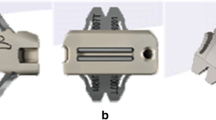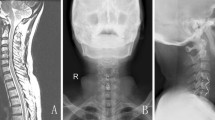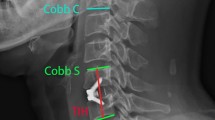Abstract
Purpose
We aimed to analyze the clinical and radiographic efficacy of a new zero-profile anchored spacer called the ROI-C in anterior discectomy and fusion (ACDF) for multilevel cervical spondylotic myelopathy (MCSM).
Method
We retrospectively reviewed the clinical, radiological outcomes and complications of multilevel ACDF with the ROI-C or with the polyetheretherketone (PEEK) cages with an anterior plate. From April 2011 to April 2014, 60 patients with MCSM were operated on using ACDF, with the ROI-C in 28 patients and PEEK cages with an anterior plate in 32 patients. The operative time, intraoperative blood loss, and clinical and radiological results were compared between the ROI-C group and the cage-plate group.
Results
The mean follow-up time was 23.8 ± 6.6 months, ranging from 12 to 36 months. At the first month and the last follow-up, the neck disability index (NDI) scores were decreased, and the Japanese Orthopedic Association (JOA) scores were significantly increased, compared with the presurgical measurements in both groups. There were no significant differences in NDI scores or JOA scores between the two groups (P > 0.05), but there were significant differences in the operation time, blood loss and the presence of dysphagia (P < 0.05). In addition, the cervical Cobb angle and disk height showed significant corrections, compared to those measured before the operation. There was no adjacent disc degeneration observed in the ROI-C group, and one patient with skip levels showed disc degeneration of the normal level between the skip levels in the cage-plate group. The degeneration rate of the cage-plate group was 3.1 %.
Conclusions
The primary clinical and radiographic efficacies of both ROI-C and cages with plates in ACDF for MCSM were satisfactory; both approaches could improve and maintain cervical lordosis and disk height. However, the ROI-C was associated with a simpler operation, a shorter operation time, less blood loss, and a lower risk of postoperative dysphagia compared to the PEEK cage with an anterior plate.




Similar content being viewed by others
References
Smith GW, Robinson RA (1958) The treatment of certain cervical-spine disorders by anterior removal of the intervertebral disc and interbody fusion. J Bone Joint Surg Am 40-A(3):607–624
Cloward RB (1958) The anterior approach for removal of ruptured cervical disks. J Neurosurg 15(6):602–617
Mummaneni PV, Kaiser MG, Matz PG et al (2009) Cervical surgical techniques for the treatment of cervical spondylotic myelopathy. J Neurosurg Spine 11(2):130–141
Kim SW, Limson MA, Kim SB, Arbatin JJ, Chang KY, Park MS, Shin JH, Ju YS (2009) Comparison of radiographic changes after ACDF versus Bryan disc arthroplasty in single and bi-level cases. Eur Spine J 18(2):218–231
Fountas KN, Kapsalaki EZ, Nikolakakos LG, Smisson HF, Johnston KW, Grigorian AA, Lee GP, Robinson JS Jr (2007) Anterior cervical discectomy and fusion associated complications. Spine (Phila Pa 1976) 32(21):2310–2317
Kalb S, Reis MT, Cowperthwaite MC, Fox DJ, Lefevre R, Theodore N, Papadopoulos SM, Sonntag VK (2012) Dysphagia after anterior cervical spine surgery: incidence and risk factors. World Neurosurg 77(1):183–187
Lowery GL, McDonough RF (1998) The significance of hardware failure in anterior cervical plate fixation. Patients with 2- to 7-year follow-up. Spine (Phila Pa 1976) 23(2):181–186
Wang Z, Jiang W, Li X, Wang H, Shi J, Chen J, Meng B, Yang H (2015) The application of zero-profile anchored spacer in anterior cervical discectomy and fusion. Eur Spine J 24(1):148–154
Hirabayashi K, Miyakawa J, Satomi K, Maruyama T, Wakano K (1981) Operative results and postoperative progression of ossification among patients with ossification of cervical posterior longitudinal ligament. Spine (Phila Pa 1976) 6(4):354–364
Bazaz R, Lee MJ, Yoo JU (2002) Incidence of dysphagia after anterior cervical spine surgery: a prospective study. Spine (Phila Pa 1976) 27(22):2453–2458
Odom GL, Finney W, Woodhall B (1958) Cervical disk lesions. J Am Med Assoc 166(1):23–28
Vaccaro AR, Carrino JA, Venger BH, Albert T, Kelleher PM, Hilibrand A, Singh K (2002) Use of a bioabsorbable anterior cervical plate in the treatment of cervical degenerative and traumatic disc disruption. J Neurosurg 97(4 Suppl):473–480
Borden AG, Rechtman AM, Gershon-Cohen J (1960) The normal cervical lordosis. Radiology 74:806–809
Chen Y, Wang X, Lu X, Yang L, Yang H, Yuan W, Chen D (2013) Comparison of titanium and polyetheretherketone (PEEK) cages in the surgical treatment of multilevel cervical spondylotic myelopathy: a prospective, randomized, control study with over 7-year follow-up. Eur Spine J 22(7):1539–1546
Ghogawala Z, Coumans JV, Benzel EC, Stabile LM, Barker FG (2007) Ventral versus dorsal decompression for cervical spondylotic myelopathy: surgeons’ assessment of eligibility for randomization in a proposed randomized controlled trial: results of a survey of the Cervical Spine Research Society. Spine (Phila Pa 1976) 32(4):429–436
Konya D, Ozgen S, Gercek A, Pamir MN (2009) Outcomes for combined anterior and posterior surgical approaches for patients with multisegmental cervical spondylotic myelopathy. J Clin Neurosci 16(3):404–409
Hee HT, Majd ME, Holt RT, Whitecloud TS, Pienkowski D (2003) Complications of multilevel cervical corpectomies and reconstruction with titanium cages and anterior plating. J Spinal Disord Tech 16(1):1–8
Vaccaro AR, Falatyn SP, Scuderi GJ, Eismont FJ, McGuire RA, Singh K, Garfin SR (1998) Early failure of long segment anterior cervical plate fixation. J Spinal Disord 11(5):410–415
Wang JC, Hart RA, Emery SE, Bohlman HH (2003) Graft migration or displacement after multilevel cervical corpectomy and strut grafting. Spine (Phila Pa 1976) 28(10):1016–1021
Burkhardt JK, Mannion AF, Marbacher S, Dolp PA, Fekete TF, Jeszenszky D, Porchet F (2013) A comparative effectiveness study of patient-rated and radiographic outcome after 2 types of decompression with fusion for spondylotic myelopathy: anterior cervical discectomy versus corpectomy. Neurosurg Focus 35(1):E4
Vanichkachorn J, Peppers T, Bullard D, Stanley SK, Linovitz RJ, Ryaby JT (2016) A prospective clinical and radiographic 12-month outcome study of patients undergoing single-level anterior cervical discectomy and fusion for symptomatic cervical degenerative disc disease utilizing a novel viable allogeneic, cancellous, bone matrix (trinity evolution™) with a comparison to historical controls. Eur Spine J. doi:10.1007/s00586-016-4414-7
Scholz M, Schleicher P, Pabst S, Kandziora F (2015) A zero-profile anchored spacer in multilevel cervical anterior interbody fusion: biomechanical comparison to established fixation techniques. Spine (Phila Pa 1976) 40(7):E375–E380
Mattei TA, Teles AR, Dinh DH (2016) Vertebral body fracture after anterior cervical discectomy and fusion with zero-profile anchored cages in adjacent levels: a cautionary tale. Eur Spine J. doi:10.1007/s00586-015-4358-3
Hillard VH, Apfelbaum RI (2006) Surgical management of cervical myelopathy: indications and techniques for multilevel cervical discectomy. Spine J 6(6 Suppl):242S–251S
Song KJ, Taghavi CE, Lee KB, Song JH, Eun JP (2009) The efficacy of plate construct augmentation versus cage alone in anterior cervical fusion. Spine (Phila Pa 1976) 34(26):2886–2892
Park MS, Kelly MP, Lee DH, Min WK, Rahman RK, Riew KD (2014) Sagittal alignment as a predictor of clinical adjacent segment pathology requiring surgery after anterior cervical arthrodesis. Spine J 14(7):1228–1234
Riley LH, Skolasky RL, Albert TJ, Vaccaro AR, Heller JG (2005) Dysphagia after anterior cervical decompression and fusion: prevalence and risk factors from a longitudinal cohort study. Spine (Phila Pa 1976) 30(22):2564–2569
Yue WM, Brodner W, Highland TR (2005) Persistent swallowing and voice problems after anterior cervical discectomy and fusion with allograft and plating: a 5- to 11-year follow-up study. Eur Spine J 14(7):677–682
Lee MJ, Bazaz R, Furey CG, Yoo J (2005) Influence of anterior cervical plate design on Dysphagia: a 2-year prospective longitudinal follow-up study. J Spinal Disord Tech 18(5):406–409
Barbagallo GM, Romano D, Certo F, Milone P, Albanese V (2013) Zero-P: a new zero-profile cage-plate device for single and multilevel ACDF. A single institution series with four years maximum follow-up and review of the literature on zero-profile devices. Eur Spine J 22(Suppl 6):S868–S878
Njoku I Jr, Alimi M, Leng LZ, Shin BJ, James AR, Bhangoo S, Tsiouris AJ (2014) Anterior cervical discectomy and fusion with a zero-profile integrated plate and spacer device: a clinical and radiological study: clinical article. J Neurosurg Spine 21(4):529–537
Park JB, Cho YS, Riew KD (2005) Development of adjacent-level ossification in patients with an anterior cervical plate. J Bone Joint Surg Am 87(3):558–563
Kao FC, Niu CC, Chen LH, Lai PL, Chen WJ (2005) Maintenance of interbody space in one- and two-level anterior cervical interbody fusion: comparison of the effectiveness of autograft, allograft, and cage. Clin Orthop Relat Res 430:108–116
Hilibrand AS, Carlson GD, Palumbo MA, Jones PK, Bohlman HH (1999) Radiculopathy and myelopathy at segments adjacent to the site of a previous anterior cervical arthrodesis. J Bone Joint Surg Am 81(4):519–528
Acknowledgments
The Natural Science Foundation of Jiangsu Province (BK20130274) supported this work.
Author information
Authors and Affiliations
Corresponding author
Ethics declarations
Conflict of interest
None.
Rights and permissions
About this article
Cite this article
Liu, Y., Wang, H., Li, X. et al. Comparison of a zero-profile anchored spacer (ROI-C) and the polyetheretherketone (PEEK) cages with an anterior plate in anterior cervical discectomy and fusion for multilevel cervical spondylotic myelopathy. Eur Spine J 25, 1881–1890 (2016). https://doi.org/10.1007/s00586-016-4500-x
Received:
Revised:
Accepted:
Published:
Issue Date:
DOI: https://doi.org/10.1007/s00586-016-4500-x




